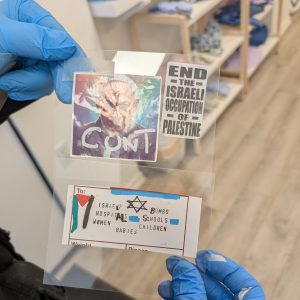David Pinkus, who was instrumental in preserving downtown Toronto’s Kensington Market, and spearheading the renovation of the Kiever Shul, died May 6, a few days shy of his 97th birthday.
“Al Waxman may have played the King of Kensington on television, but Dave Pinkus was the true king of Kensington,” Ernie Pinkus said at the funeral of his cousin.
A graduate of Harbord Collegiate, where he competed in track-and-field and on the basketball team, Pinkus was a lifelong advocate for the neighbourhood he grew up in.
“My endeavours with the community were my highest achievement,” he said in a 2013 interview conducted by the Ontario Jewish Archives, Blankenstein Family Heritage Centre.
Although modest in temperament, Pinkus passionately protected the market from destruction when the City of Toronto wanted to bulldoze and redevelop the area, and he helped successfully fight the Spadina Expressway.
“This community would have disappeared if we had not stood our ground in the 1960s and ’70s,” he said in the 2013 film, A Portrait of David Pinkus by Aaron Rotenberg.
Community was important to him, Rabbi Eli Cohen, spiritual leader of the Kiever said, noting that Pinkus regularly helped new immigrants integrate into Canadian society.
Pinkus became best known for leading the restoration of the Kiever Shul, one of the few active remnants of Jewish downtown’s past. He oversaw the renovation process, a 40-plus-year project that is still ongoing.
Officially known as the First Russian Congregation of Rodfei Sholem Anshei Kiev, the Kiever has been located at 25 Bellevue Ave. since 1927.
That same year Pinkus’s parents, Mollie and Isadore, who were co-founders of the shul, moved into their home nearby on Nassau Street. He lived there until his death.
At the University of Toronto, he studied mechanical engineering, although Jewish graduates had trouble finding jobs in that era.
Pinkus was first hired by Goodyear Tire. He then taught mechanical drawing at the UofT’s engineering school before moving to Montreal to work as a project engineer for CIL.
After three-and-a-half years, he returned home to help his widowed mother and physically disabled sister.
From 1954 to 1958 he worked on the Avro Arrow, the famous Canadian military jet.
While he held other engineering jobs, Pinkus served on the boards of the Toronto Western and the Toronto General hospitals, along with Mount Sinai Memorial Park.
Aaron Levy, the founding rabbi and executive director of Makom: Creative Downtown Judaism, spoke of Pinkus’s support for the newer grassroots group.
“David appreciated and valued what we were doing in revitalizing downtown Jewish life in and around the market and that we were reaching a younger generation.”
Pinkus also supported the work of Shoresh Jewish Environmental Programs.
At a shiva held on Zoom, Sabrina Malach, director of community outreach at Shoresh, spoke about Pinkus’s generosity in offering his backyard for its garden.
Pinchas Gutter, the Kiever’s cantor since the mid-’80s, recalled how Pinkus and his late brother, Max, looked after their ailing mother as if they were nurses.
Ernie Pinkus shared memories of how Isadore and Mollie took in his widowed grandmother and her children. David became like a generous uncle, who took him to the Canadian National Exhibition and bought him his first bike.
Ernie said his cousin foresaw the cultural and financial value in preserving Kensington Market, and predicted the Jewish community migrating north would regret leaving downtown behind.
“David said, ‘One day this will be the hottest area in the entire city.’ And he was right!”







